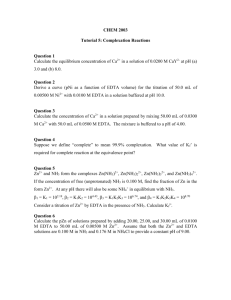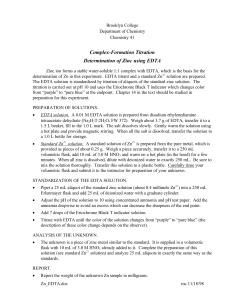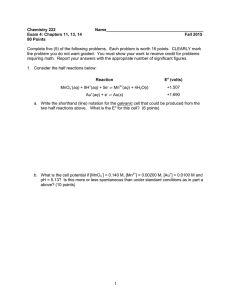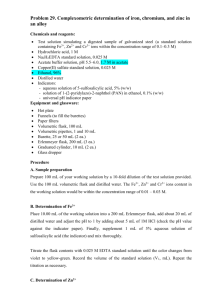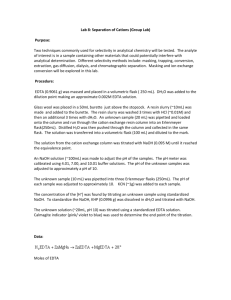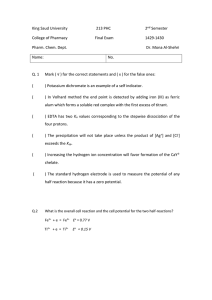Name:_____________ Chemistry 232
advertisement
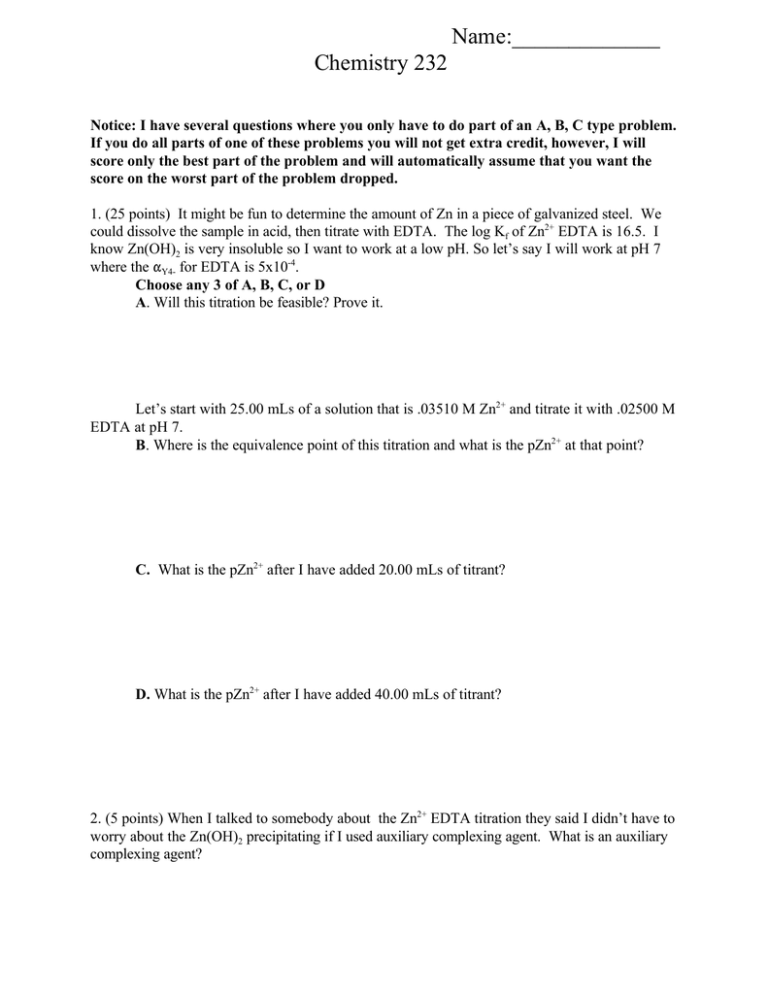
Name:_____________ Chemistry 232 Notice: I have several questions where you only have to do part of an A, B, C type problem. If you do all parts of one of these problems you will not get extra credit, however, I will score only the best part of the problem and will automatically assume that you want the score on the worst part of the problem dropped. 1. (25 points) It might be fun to determine the amount of Zn in a piece of galvanized steel. We could dissolve the sample in acid, then titrate with EDTA. The log Kf of Zn2+ EDTA is 16.5. I know Zn(OH)2 is very insoluble so I want to work at a low pH. So let’s say I will work at pH 7 where the "Y4- for EDTA is 5x10-4. Choose any 3 of A, B, C, or D A. Will this titration be feasible? Prove it. Let’s start with 25.00 mLs of a solution that is .03510 M Zn2+ and titrate it with .02500 M EDTA at pH 7. B. Where is the equivalence point of this titration and what is the pZn2+ at that point? C. What is the pZn2+ after I have added 20.00 mLs of titrant? D. What is the pZn2+ after I have added 40.00 mLs of titrant? 2. (5 points) When I talked to somebody about the Zn2+ EDTA titration they said I didn’t have to worry about the Zn(OH)2 precipitating if I used auxiliary complexing agent. What is an auxiliary complexing agent? 2 3. (25 points) I have decided to try the titration outlined in problem 1 at pH 10 using a 1F ammonia buffer. (IE Zn and EDTA concentrations are the same as problem 1) Chose any 4 of A, B, C, D, or E A. What is the concentration of NH3 at this pH? (pKa of NH4+ is 9.244) Since Zn forms complexes with ammonia, we can find the fraction of free Zn using the equation: α Zn2+ = 1 1 + 151[ NH3 ] + 2.63x10 [ NH3 ] + 5.50 x10+6 [ NH3 ]3 + 5.01x10 +8 [ NH3 ]4 4 2 B. What is the value of " C. Assume you start with the same solution of 25.00 mLs .03510 M Zn2+ what is the concentration of free Zn2+ in this solution? D. If the pH is 10, the "Y4- for EDTA is .36. What is my Kf”? E. Assume you are titrating with .02500 M EDTA what is the pZn2+ at the equivalence point now? (Note: I want the concentration of Zn2+ not complexed with either EDTA or NH3 .) 3 4. Given the two reactions: Cu2+(aq) + 2e- 6Cu(s) Ag+(aq) + e-6 Ag(s) Eo= .339 Eo= .799 A.( 10 points) Diagram a galvanic cell that uses the following ½ reactions to generate a current. On this diagram include the following details: Flow of electrons, anode, cathode, + pole, - pole, salt bridge, metal of electrodes, ions in solution B. (5 points) What is the potential of this cell if I have 1 M solutions of each of the ions? C. (10 points) What is the potential of this cell if I use 0.01M AgNO3 and .005M CuNO3 as my solutions? 4 5. In class I said that biochemists use Eo’ as a way to help them predict reaction pathways and energy flow. As part of our metabolic breakdown of glucose to CO2 and H2O, there is a reaction that involves Succinate, Fumarate, FAD, and FADH2 . The potentials of these ½ reactions are given below: Fumarate + 2H+ + 2e- W Succinate Eo’ = .031 + FAD + 2H + 2e W FADH2 Eo’= -.219 A. (5 points) What should the net reaction be: B. (10 points) Assuming 1M concentrations of all reactants and products except H+, what is the Keq and )G for this reaction? (F= 9.65x104 C/mol) C. (5 points) In the cell the reaction that actually occurs is Succinate + FADW Fumarate + FADH2. Is this consistent with your above answer? If not, can you explain how a cell can perform a reaction that appears to be thermodynamically disfavored? 6. (15 points) Either Diagram one standard reference cell and give its potential. Or Diagram and explain a pH electrode

